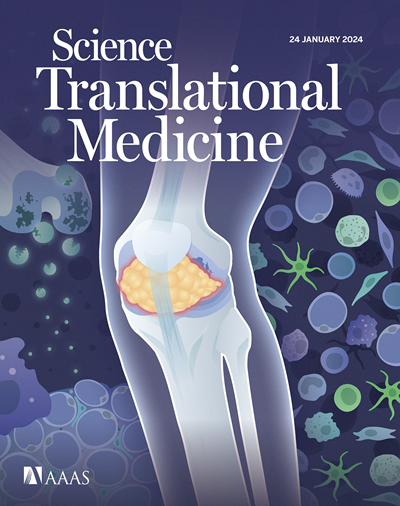抑制受体siglece控制抗原呈递细胞活化和T细胞介导的移植排斥反应
IF 15.8
1区 医学
Q1 CELL BIOLOGY
引用次数: 0
摘要
移植后,炎症和组织损伤释放危险信号,激活骨髓细胞,驱动适应性免疫反应和急性排斥反应。目前的免疫抑制剂主要针对T细胞,但不能充分控制先天免疫。在移植中控制先天反应的调控信号仍然难以捉摸。唾液酸结合免疫球蛋白样凝集素- e (siglece,或SigE)结合唾液化配体抑制炎症。在小鼠心脏移植中,SigE在移植物浸润的髓细胞中上调,包括树突状细胞(dc)。受体(而非供体)SigE缺乏可通过增强DC激活、核因子κB (NF-κB)信号传导和肿瘤坏死因子-α (TNF-α)产生加速急性排斥反应,从而促进同种异体T细胞反应。相反,SigE在dc上的过表达降低了危险信号的激活及其T细胞的异源刺激能力。人类同源蛋白Siglecs-7和-9在异体移植物活检中被上调,它们的高表达与异体移植物存活率的提高相关。因此,SigE/7/9是一个重要的抑制受体,控制抗原提呈细胞活化和T细胞介导的移植排斥反应,具有治疗潜力。本文章由计算机程序翻译,如有差异,请以英文原文为准。
The inhibitory receptor Siglec-E controls antigen-presenting cell activation and T cell–mediated transplant rejection
After transplantation, inflammation and tissue injury release danger signals that activate myeloid cells, driving adaptive immune responses and acute rejection. Current immunosuppressants primarily target T cells but inadequately control innate immunity. Regulatory signals controlling innate responses in transplantation remain elusive. The sialic acid–binding immunoglobulin-like lectin-E (Siglec-E, or SigE) binds sialylated ligands to suppress inflammation. In mouse heart transplants, SigE is up-regulated in graft-infiltrating myeloid cells, including dendritic cells (DCs). SigE deficiency in recipients, but not donors, accelerates acute rejection by enhancing DC activation, nuclear factor κB (NF-κB) signaling, and tumor necrosis factor–α (TNF-α) production, thereby boosting alloreactive T cell responses. Conversely, SigE overexpression on DCs reduces activation by danger signals and their T cell allostimulatory capacity. The human homologs Siglecs-7 and -9 were up-regulated in rejecting allograft biopsies, and their higher expression correlated with improved allograft survival. Thus, SigE/7/9 is a crucial inhibitory receptor controlling antigen-presenting cell activation and T cell–mediated transplant rejection, offering therapeutic potential.
求助全文
通过发布文献求助,成功后即可免费获取论文全文。
去求助
来源期刊

Science Translational Medicine
CELL BIOLOGY-MEDICINE, RESEARCH & EXPERIMENTAL
CiteScore
26.70
自引率
1.20%
发文量
309
审稿时长
1.7 months
期刊介绍:
Science Translational Medicine is an online journal that focuses on publishing research at the intersection of science, engineering, and medicine. The goal of the journal is to promote human health by providing a platform for researchers from various disciplines to communicate their latest advancements in biomedical, translational, and clinical research.
The journal aims to address the slow translation of scientific knowledge into effective treatments and health measures. It publishes articles that fill the knowledge gaps between preclinical research and medical applications, with a focus on accelerating the translation of knowledge into new ways of preventing, diagnosing, and treating human diseases.
The scope of Science Translational Medicine includes various areas such as cardiovascular disease, immunology/vaccines, metabolism/diabetes/obesity, neuroscience/neurology/psychiatry, cancer, infectious diseases, policy, behavior, bioengineering, chemical genomics/drug discovery, imaging, applied physical sciences, medical nanotechnology, drug delivery, biomarkers, gene therapy/regenerative medicine, toxicology and pharmacokinetics, data mining, cell culture, animal and human studies, medical informatics, and other interdisciplinary approaches to medicine.
The target audience of the journal includes researchers and management in academia, government, and the biotechnology and pharmaceutical industries. It is also relevant to physician scientists, regulators, policy makers, investors, business developers, and funding agencies.
 求助内容:
求助内容: 应助结果提醒方式:
应助结果提醒方式:


